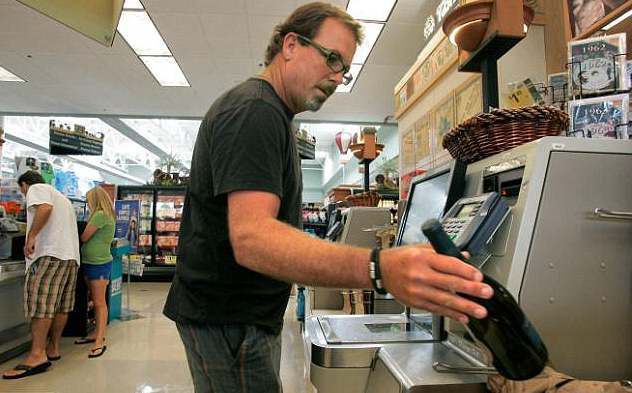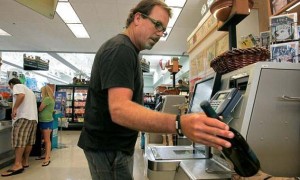导读:科技的发展,成本的控制,使得很多超市引入了自助结账系统,面对无人监督的情况,你会乖乖结账吗?

They are already a major source of frustration.
它们已成为挫折的主要来源。
But self-service checkouts may not just be sending stress levels soaring – they could also be turning honest shoppers into thieves.
然而,自助结账台可能不仅仅使紧张程度飙升-它们还能把诚实的顾客变成小偷。
A Leicester University report has revealed that a shop’s losses are more than double when self-service technology is used.
一份莱斯特大学的报道揭露,一家商店在使用了自助服务技术后损失翻番还不止。
While some of the items may have found their way into shopping bags by mistake, others are likely to have been pilfered – and not just by hardened criminals.
除了有些商品误打误撞进入了购物袋,其他商品很可能被偷了-而且不仅仅是被惯犯。
Interviews with supermarket managers and staff suggest that normally honest people give into temptation when left to scan their own shopping.
这家超市经理和员工在接受采访时称,在要求自己扫描货物付款时,平时诚实的顾客更容易受到诱惑。
The lack of human contact may lead some to believe it is a harmless crime, while others may rationalise their theft by telling themselves that a big store can afford it.
缺少人员沟通可能会导致有些人认为这是一场无害的犯罪,而另外一些人可能告诉自己,这么大的商店肯定承担得起这点损失,从而将自己的偷窃合法化。
And some shoppers may simply be so frustrated with the technology that they feel justified in stealing.
一些顾客可能仅仅是对不太搞得定这项新技术,以至于他们觉得偷窃是合乎情理的。
Distraction is also an issue, particularly with the most hi-tech systems in which customers use their mobile phones to scan items as they walked around the aisles.
注意力分散同样是个问题,尤其是在高科技发展的当代,顾客一边使用手机扫描商品一边在通道附近转悠。
In some cases, 10 per cent of the items are not scanned due to customers forgetting to use the technology consistently.
某些情况下,10%的商品是由于顾客忘记使用这项技术而没有被扫描。
And a separate audit of one million shopping trips found that losses including theft more than doubled with self-scanning.
一项独立审计发现,在一百万次购物中,使用自助扫描系统会使包括盗窃在内的损失增加一倍以上。
Report co-author Adrian Beck, a professor of criminology, said: ’Both loved and loathed by consumers, with the phrase ’unexpected item in the bagging area’ striking dread into many a shopper, self-scan technologies are growing in use and likely to become even more prominent as we begin to be encouraged to use our own mobile devices to both scan and pay for products in the stores we visit.
这份报告的联合作者犯罪学教授艾德里安贝克说:“顾客对它是又爱又恨,尤其是那句非常洗脑的‘装袋区出现意外物品’分分钟把你逼疯。自助扫描技术使用地越来越多,而且很可能占主导地位,因为我们开始被鼓励用自己的移动设备扫描和支付在商店购买的产品。”

From the retailers’ perspective, the benefits seem obvious – less investment required in staff and checkout technologies, with the former being the biggest expense they face.
“从零售商的角度来看,好处似乎很明显-人工和结账技术的投资减少,而前者是他们所面临的最大开销。”
For the shopper it could mean the end of checkout queues as product scanning and payment can in theory be performed anywhere in the store at their convenience. To borrow a well-warn Top Gear phrase, ’what could possibly go wrong’?
“对消费者来说,这可能意味着他们再也无须排队结账,因为理论上商品扫描和付款可以在他们方便时在商店任意处完成。借用TOP GEAR的一句话,‘哪里会出错呢?’”
Well, our research found that quite a bit could and does go wrong, with some potentially rather worrying long term consequences.’
“好吧,我们的研究发现相当多的地方可能而且确实出错了,一些人宁愿去排长队结账。”
The report also warns that customers who are caught stealing have ’ready-made excuses’ – including blaming faulty technology or their own lack of computer savvy.
该报告同时提醒那些被抓到盗窃的消费者,准备好“现成的借口”-包括指责有缺点的技术或他们自己不懂电脑知识。
As a result, ’proving intent is difficult’ and ’deciding whether prosecutions can be made or not is potentially a legal and customer relations minefield’.
结果只能是“难以证明作案动机”和“决定是否起诉可能是个法律和客户关系的雷区”。
However, retailers are wising up by tagging products and introducing prompts that require shoppers to state they have scanned all their items.
然而,零售商通过为产品贴标签以及引入需要顾客陈述已扫描所有商品的提示来改善现状。
Co-researcher Dr Matt Hopkins said: ’Retailers are becoming aware of these problems and introducing ways of…trying to ensure that all that ends up in the basket also makes it onto the receipt.’
联合研究者马特霍普金博士说:“零售商逐渐意识到这些问题,并引入方法……试图确保所有进入购物车的商品最终也会进入收据中。”







